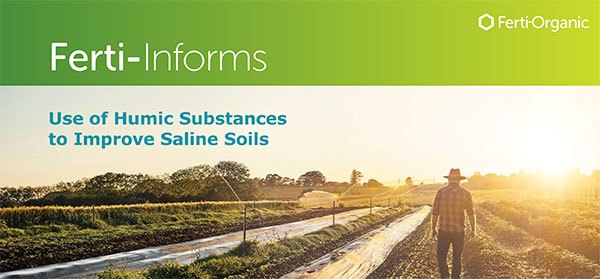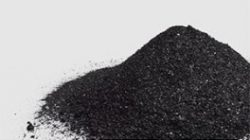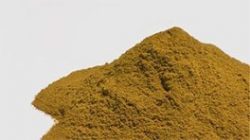
Humic substances
The soil contains large quantities of organic matter from decaying animals and plants. Organic vegetable and animal residues, managed or deposited in different environments or on the soil, undergo a microbial transformationprocess comprising mineralization and humidification.
This process results in humic substances: complex molecules of high molecular weight with colloidal and hydrophilic properties and medium- and long-term nutritional release. Most of the humic acids on the market are obtained from Leonardite, given their higher quality and superior agronomic properties.
Humic substances are classified based on the solubility of their components in solutions of different pH levels.Humic acids have two main derivatives:

HUMIC ACID
Long chain polymer, high molecular weight, dark brown to black in color, and soluble in alkaline solutions.
Fig. 3. Characterization of humic acid

FULVIC ACID
Short chain polymer, low molecular weight, yellow color and soluble in acidic and alkaline solutions.
Fig 4. Characterization of fulvic acid.
Humins, the insoluble humus in alkali, are also derived from humic substances, as is himatomelanic acid, the component of humic acid soluble in alcohol.
The Problem with Saline Soils
Soils may become saline due to lack of drainage and high evaporation, resulting in salt build-up. Salinization can also be induced secondarily, by man, as a consequence of excessive irrigation caused by improper management of irrigation facilities, poor internal drainage and poor irrigation water quality, as well as excess inorganic fertilization (Liang et al., 2005).
High salt concentrations in crops delay growth and cause discolorations and shades that directly affect photosynthesis, reducing crop yield. They can also cause burns in leaf veins.
To combat this problem, organic matter is added to the soils to improve the structure, increase the cationic exchange capacity and affect the microbiological oxidation of certain metals.
The Benefits of Incorporating Humic Acids Intro Alkaline Soils
In sustainable agriculture, stresses caused by salt concentration in soils are mitigated by the application of humic substances formed by plant or animal wastes, substances that provide high nutritional content, promote bacterial growth and speed up the degradation of contaminants in the soil (Eweis et al., 1999).
Scientific research has shown that humic acids in soil benefit plant growth in the following ways:
Physical:
- Prevent soil compaction by promoting the formation of steady aggregates between particles, thus achieving better aeration and water circulation.
- Improve soil infiltration and water retention.
- Make the soil more crumbly.
- Darken the soil, improving solar energy absorption and stimulating microbial activity.
- Prevent salt build-up from fertilizers.
Chemical:
- Help neutralize acidic and alkaline soils with charged colloidal particles, creating a double ionic layer.
- Provide the carboxylic and phenolic groups that are chelating agents, binding cations in steady organomineral complexes.
- Provide colloids, a key point for the cation exchange reactions that significantly improve plant growth.
- Accelerate mineral decomposition by releasing essential nutrients as interchangeable cations.
- Draw positive ions (K +, Ca + 2, Mg + 2, Fe + 3, Cu + 2, Mn + 2, Zn + 2), preventing loss by leaching.
Biological:
- Provide a source of organic carbon, a substrate stimulating their growth and proliferation of beneficial soilmicro-organisms.
- Stimulate root respiration and vertical growth, improving nutrient absorption.
- Provide the amino acids, auxins and gibberellins that are determining compounds in the development of plants.
- Increase the likelihood of seed germination and viability.
- Improve photosynthesis and respiration as well as mRNA and protein synthesis.
Numerous scientific articles describe the beneficial effect of humic acid application on saline soils. Jacqueline A.Hernández Araujo (2007) mentions in her doctoral dissertation at the Polytechnic University of Madrid that the use of organic amendments, compost and vermicompost, in 1.5% ratios could be used for the biorecovery of saline- sodic soils. Treatment with humic substances was also found to achieve a greater harvest index, panicle dry weight and plant height in a sorghum crop (Ramírez et al., 1998). An experiment where saline-sodium soil was improved with humic acids extracted from compost and soil used for Tagetes erecta L. cultivation concluded that the humicsubstances significantly improved marigold flower production.
Sources:
Eweis, J., Ergas, S., Chang, D., Schroeder, E., 1999. Principios de biorecuperación (Principles of Biorecovery). McGraw-Hill, Madrid, Spain, p.327.
Hernández Araujo, J. A., 2011. Biorecovery of saline soils with the use of organic materials. Doctoral thesis, Polytechnic University of Madrid, p.119.
Liang, Y., Nikolic M., Peng Y., 2005. “Organic manure stimulates the biological activity and growth of barley in soil subject to secondarysalinization.” Biología de suelo y bioquímica (Soil Biology and Biochemistry), Vol. 37, No. 6 (pp. 1185-1195).
Ramirez S., Gabriel Alcantar Glz, Manuel O. Escobar, Alberto Escalante E., Marcos Soto Hernández, Prometeo Shez García, 1997. “Organic and inorganic foliar fertilization and yield of sorghum in salinity conditions.” Terra, Vol. 16, No. 3.
López Cervantes, Rubén, 2018. “Use of humic substances in agriculture.” Conference presented in the Fertigation Graduate Program, UAAAN University (Universidad Autónoma Agraria Antonio Narro (UAAAN)





 (956) 574-8280
(956) 574-8280 info@ferti-organic.com
info@ferti-organic.com